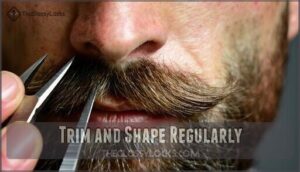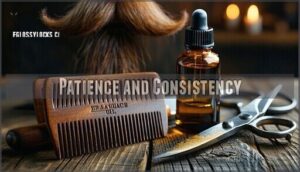This site is supported by our readers. We may earn a commission, at no cost to you, if you purchase through links.
 Your prickly mustache doesn’t have to feel like sandpaper against your partner’s face. Learning how to make your mustache softer starts with ditching regular soap, which strips away natural oils.
Your prickly mustache doesn’t have to feel like sandpaper against your partner’s face. Learning how to make your mustache softer starts with ditching regular soap, which strips away natural oils.
Instead, use beard shampoo twice weekly and apply beard oil daily to hydrate those coarse hairs. Think of it like watering a plant – consistency matters.
Brush downward with a boar bristle brush to distribute oils evenly, and trim split ends every few weeks. Don’t forget beard conditioner after washing.
Your mustache is basically head hair that got lost – treat it with the same care, and you’ll discover game-changing techniques that most guys never learn.
Table Of Contents
- Key Takeaways
- How to Make Your Mustache Softer?
- Examine Your Grooming Routine
- Cleaning and Conditioning Habits
- Incorporate Oils and Balms
- Trim and Shape Regularly
- Brush and Comb Techniques
- Using Home Remedies
- Patience and Consistency
- Frequently Asked Questions (FAQs)
- How do I get a softer mustache?
- How to soften beard & mustache hair?
- How to make a mustache softer after shaving?
- How do you maintain a smooth mustache?
- How do you fill a patchy mustache?
- Can you use conditioner on a mustache?
- How do I make my moustache soft?
- Why is my mustache so rough?
- How to make a mustache less wiry?
- How do I get rid of irritated mustache?
- Conclusion
Key Takeaways
- Ditch regular soap and use beard-specific products – You’ll want to wash with sulfate-free beard shampoo twice weekly and apply beard oil daily to hydrate coarse hairs and prevent stripping natural oils.
- Brush and distribute oils properly – You should brush downward with a boar bristle brush twice daily to evenly distribute oils throughout your mustache and stimulate healthy growth.
- Trim regularly to prevent damage – You need to trim split ends every 2-4 weeks using quality scissors or trimmers to maintain softness and encourage healthier regrowth.
- Stay consistent and patient – You won’t see overnight results, but if you stick with your routine for 3-4 weeks, you’ll notice significant softening and improved texture in your mustache.
How to Make Your Mustache Softer?
Getting a soft mustache isn’t rocket science, but it does require the right approach.
Your facial hair becomes rough when it lacks proper grooming habits and essential nutrients.
Rough mustaches don’t happen overnight—they’re the result of neglect, poor habits, and missing the basics that truly matter.
Start by switching to a sulfate-free beard wash and conditioner** that won’t strip away natural oils.
Hydration Importance can’t be overstated—drink plenty of water daily.
Diet Impact matters too; foods rich in biotin like nuts and eggs support healthy hair growth.
Sleep Quality and Stress Reduction also play vital roles in hair texture.
Consider Supplement Choices like vitamin E for extra nourishment.
These mustache softening tips and mustache care tips form the foundation of soft mustache grooming.
Master these mustache grooming tips and mustache softness techniques for lasting results.
Examine Your Grooming Routine
Your mustache won’t magically transform overnight, but examining your current grooming habits is the first step toward softer facial hair.
Most guys stick to the same routine without questioning whether it’s actually working. Time for a reality check.
Start by auditing your product ingredients – are you using sulfate-free and alcohol-free beard products? These gentler formulas won’t strip your mustache’s natural oils like harsh chemicals do.
Your application frequency matters too. Overdoing it can backfire, leaving your facial hair drier than before.
Don’t neglect tool maintenance either. Clean brushes and combs work better and last longer.
Routine customization is essential since every mustache is different. What works for your buddy mightn’t work for you.
Consider adding a nighttime routine with beard oil or balm. These mustache grooming tips form the foundation of effective mustache care.
Cleaning and Conditioning Habits
Your mustache won’t soften overnight, but the right cleaning and conditioning habits can make a huge difference in just a few weeks.
Most guys treat their facial hair like regular hair, which is why they end up with a scratchy mess instead of the smooth mustache they want.
Consistent Beard Washing
A proper mustache care routine starts with smart washing frequency. You don’t need to scrub daily like your scalp hair—2-3 times weekly works best.
Even simpler styles require consistent mustache training to achieve the desired shape and texture.
- Choose sulfate-free mustache shampoo to preserve natural oils
- Use lukewarm water temperature to prevent dryness and irritation
- Practice gentle cleansing with soft circular motions
- Pat dry carefully to avoid rough towel damage
Applying Beard Conditioners
After washing comes the real game-changer: beard conditioner. Apply a quarter-sized amount to damp facial hair, massaging from roots to tips.
Let it sit for 3-5 minutes—this isn’t a rush job. Rinse with lukewarm water or choose leave-in formulas for ongoing mustache softness.
Quality conditioner ingredients like argan oil transform wiry whiskers into touchably soft facial hair. Beard conditioners are specially formulated to address thicker facial hair.
Incorporate Oils and Balms
Oils and balms work like magic potions for your mustache, turning scratchy whiskers into smooth, touchable facial hair.
You’ll want to make these products your best friends since they moisturize both your hair and the skin underneath, preventing that annoying itch while keeping everything soft.
Benefits of Beard Oils
Beard oils work like magic for your mustache.
These liquid gold elixirs deliver skin hydration and itch reduction while promoting hair nourishment.
The right mustache oil tackles dryness at its source, offering growth promotion and shine enhancement.
Beard oil for mustache care isn’t just hype—it’s science.
Many use it for overall beard health.
Apply a few drops daily, and you’ll notice improved mustache softness within weeks.
Styling With Beard Balms
After oils work their magic, balms become your mustache’s best friend for styling and control.
Transform your rough whiskers into silky perfection with the right balm application technique.
Scrape a pea-sized amount with your thumbnail, warm it between palms, then work through your facial hair.
Mustache balm benefits include:
- Light to medium hold strength for shaping
- Extra conditioning from shea butter ingredients
- Taming flyaways for polished mustache styling
Perfect for achieving that well-groomed look.
Trim and Shape Regularly
Keeping your mustache soft and tidy starts with regular trims. Think of it like mowing the lawn—you’re not just keeping it neat, but also encouraging healthier growth.
Use quality trimming tools, like scissors or a beard trimmer, to snip away split ends and manage unruly patches. This isn’t just about looks; split ends can make your mustache feel rough and wiry.
Start with a longer guard on your trimmer, then gradually shorten it until you hit your desired length. Got a few stubborn strays? Snip them carefully for a polished finish.
Regular mustache grooming every two to four weeks helps maintain style and prevents overgrowth. You can maintain the shape and fullness by following a regular trimming schedule.
Trimming also impacts growth by encouraging softer regrowth, making your mustache more manageable. Whether you’re aiming for a bold look or subtle refinement, consistent mustache care keeps things sharp, soft, and totally lip-friendly.
Brush and Comb Techniques
Your grooming techniques matter just as much as the products you use.
A boar bristle brush works wonders for oil distribution and mustache softness.
Bristle density should match your hair thickness—denser bristles handle coarse whiskers better.
Choose quality comb material like wood or horn to prevent static and snagging during detangling methods.
Brush twice daily using gentle styling techniques, always combing outward from the center.
This mustache grooming routine stimulates follicles and removes debris.
Consistent mustache care routine transforms rough whiskers into manageable facial hair through proper grooming techniques.
For ideal detangling, consider using a sandalwood beard comb.
Using Home Remedies
Now that you’ve mastered brushing techniques, let’s explore wallet-friendly kitchen remedies that’ll transform your scratchy whiskers.
Your pantry holds powerful DIY softeners that rival expensive products. Start with olive oil overnight treatments – massage a few drops into your mustache before bed. This natural mustache oil penetrates deep, delivering intense hydration boost while you sleep.
For weekly pampering, create a homemade mustache softener using honey and mashed avocado. These natural ingredients work like magic on coarse hair.
Here are four kitchen remedies that deliver real results:
- Coconut oil mask – Apply warm oil for 20 minutes
- Honey-egg mixture – Weekly deep conditioning treatment
- Coffee ground scrub – Gentle exfoliation removes dead skin
- Avocado paste – Rich moisturizing for dry, brittle hair.
These mustache softness remedies cost pennies compared to store-bought alternatives, yet they’ll leave your facial hair feeling silky smooth.
Patience and Consistency
While home remedies can work wonders, transforming your mustache from sandpaper to silk requires patience and consistency. You won’t wake up tomorrow with a baby-soft mustache – it’s more like training for a marathon than sprinting to the finish line.
Your facial hair needs time to adjust to its new pampering routine. Stick with your mustache care regimen for at least 3-4 weeks before expecting dramatic results. Daily effort in applying oils, conditioning, and proper grooming creates the foundation for long-term softness.
Here’s what to expect during your mustache grooming journey:
| Timeline | What You’ll Notice | Key Actions |
|---|---|---|
| Week 1-2 | Less itchiness, slight texture improvement | Focus on routine adherence |
| Week 3-4 | Noticeable softening, easier styling | Maintain consistent hydration |
| Month 2+ | Gradual improvement continues, mustache softness achieved | Stick with proven methods |
Remember, consistency beats perfection every time.
Frequently Asked Questions (FAQs)
How do I get a softer mustache?
You’ll want to use beard oil daily after showering, brush with natural bristles to distribute oils, and apply a quality conditioner.
Stay hydrated, eat biotin-rich foods, and avoid harsh shampoos that strip natural oils.
How to soften beard & mustache hair?
Like discovering silk where sandpaper once lived, you’ll transform rough facial hair through daily conditioning.
Use beard oil after washing, apply balm when damp, and brush regularly.
Your face will thank you.
How to make a mustache softer after shaving?
After shaving, apply a gentle beard conditioner while showering, then use moisturizing beard oil or balm.
Brush with natural bristles to distribute products evenly.
You’ll notice softer whiskers within days of consistent care.
How do you maintain a smooth mustache?
Daily conditioning with beard oil keeps your mustache smooth and manageable.
Brush it twice daily with natural bristles to distribute oils evenly.
Trim regularly to prevent split ends, and stay hydrated for healthier hair growth.
How do you fill a patchy mustache?
My buddy Jake grew tired of his scraggly mustache looking like a moth-eaten sweater.
You can fill patchy spots by using minoxidil, taking biotin supplements, and brushing regularly to stimulate growth in sparse areas.
Can you use conditioner on a mustache?
You can use conditioner on your mustache, but skip regular hair conditioner—it’ll dry out your face. Use a beard-specific conditioner instead. It’s gentler and won’t irritate your skin underneath.
How do I make my moustache soft?
Apply beard oil or balm daily after washing to hydrate coarse hairs.
Brush with natural bristles to distribute oils evenly.
Condition regularly with facial hair products, not scalp shampoo, which strips moisture.
Why is my mustache so rough?
Your mustache feels rough because it’s naturally thicker and coarser than scalp hair due to testosterone.
Weather, dehydration, and lack of proper conditioning strip away natural oils, leaving you with prickly, brittle whiskers.
How to make a mustache less wiry?
Seventy percent of men experience wiry facial hair due to hormonal changes.
You’ll soften yours by applying beard oil daily, conditioning twice weekly, and brushing with boar bristles to distribute natural oils evenly throughout stubborn strands, which will also help with conditioning.
How do I get rid of irritated mustache?
Stop touching that irritated mustache constantly – you’re only making it worse.
Wash gently with sulfate-free cleanser, apply beard oil twice daily, and let a soft bristle brush distribute natural oils evenly.
Conclusion
Sure, learning how to make your mustache softer might seem time-consuming, but these simple steps take just minutes daily.
You’ve got the tools now – beard oil, proper washing, regular trimming, and consistent brushing.
Your mustache won’t transform overnight, but stick with this routine for two weeks and you’ll notice real results.
Stop letting rough facial hair ruin intimate moments.
Start tonight with one technique, then gradually add others until your mustache feels amazingly soft.










